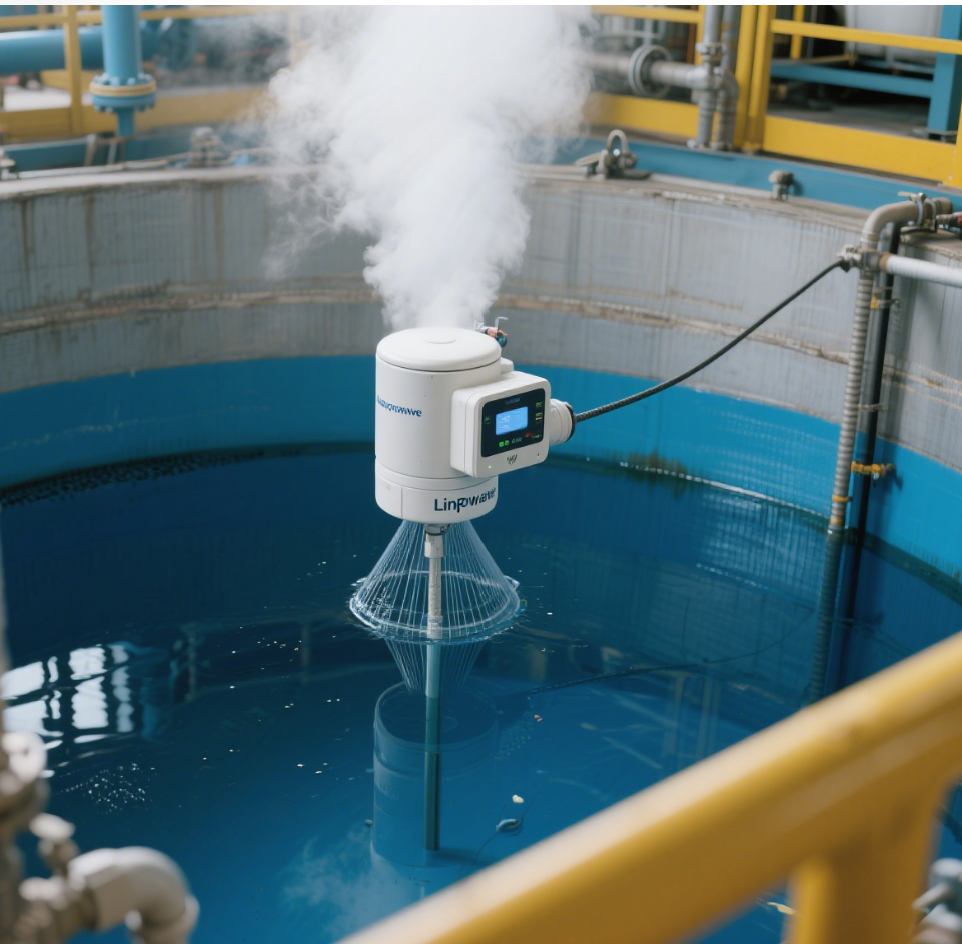Introduction
In modern chemical processing facilities, maintaining precise liquid level measurements in storage tanks is crucial for safety, operational efficiency, and regulatory compliance. Many chemical processes involve high-temperature liquids that generate significant steam, creating challenging measurement conditions. Additionally, condensation can form on sensor surfaces due to temperature differentials within the tank, further complicating accurate measurement.
Traditional level measurement devices, including float switches and ultrasonic sensors, often struggle under these conditions. Signal distortion, refraction, or scattering caused by steam and condensation can lead to inaccurate readings, triggering unnecessary alarms, production interruptions, or even safety risks.
Linpowave’s millimeter-wave radar technology is specifically engineered to overcome these challenges, delivering precise, reliable, and non-contact measurements in harsh industrial environments. By leveraging high-frequency radar waves, advanced signal processing, and intelligent algorithms, Linpowave provides a robust solution for chemical tank applications.
Challenges in Steam and Condensation Environments
Steam Interference
High-temperature chemicals in storage tanks produce vapor above the liquid surface. This steam layer has a refractive index different from air, causing radar waves to bend or scatter as they propagate. As a result, conventional sensors can misinterpret the liquid surface position, resulting in inaccurate measurements.
For example, ultrasonic sensors can be absorbed or deflected by steam, while optical sensors may experience signal attenuation or inconsistent reflections. Even minor inaccuracies can lead to process inefficiencies, overfilling risks, or wasted product.
Condensation Effects
Condensation occurs when humid vapor meets cooler surfaces within the tank or on the sensor itself. These liquid droplets can alter the electromagnetic properties of the measurement path, creating additional reflections or signal absorption. Non-contact sensors can partially mitigate this effect, but careful design and signal processing are required to ensure stability.
Combined, steam and condensation create a dynamic and unpredictable measurement environment, demanding a solution capable of maintaining accuracy under varying conditions.
Linpowave Millimeter-Wave Radar Solution
Linpowave radar sensors operate at 76–81 GHz, providing millimeter-level resolution and exceptional signal penetration. This high-frequency operation delivers several advantages in challenging environments:
-
High Resolution and Accuracy
Millimeter-wave radar waves are less susceptible to refraction and scattering caused by steam, enabling precise liquid level measurements. Linpowave’s sensors maintain accuracy even in tanks with varying vapor densities, ensuring reliable data for process control. -
Non-Contact Measurement
Non-contact measurement eliminates direct interaction with liquids or condensation, reducing maintenance needs and avoiding sensor fouling. This design ensures long-term stability in corrosive or high-temperature chemical environments. -
Advanced Signal Processing and Intelligent Algorithms
Linpowave sensors incorporate sophisticated algorithms that filter out noise caused by vapor turbulence or condensation droplets. The system distinguishes between actual liquid surfaces and transient interferences, maintaining consistent readings even during sudden temperature changes or tank agitation. -
All-Weather Industrial Reliability
These sensors are designed for industrial applications, capable of operating in temperatures from -40°C to 85°C and handling vapor-rich atmospheres without degradation in performance.
By combining these features, Linpowave radar sensors overcome the traditional limitations of level measurement technologies in steam and condensation-prone tanks.
Real-World Applications
Linpowave millimeter-wave radar sensors have been deployed in multiple chemical and industrial facilities with excellent results:
-
Chemical Storage and Distribution Centers
Facilities storing corrosive or high-temperature chemicals often face vapor interference. Linpowave sensors provide precise monitoring, preventing overfills, reducing safety risks, and optimizing inventory management. -
Industrial Process Control
In chemical production plants, maintaining accurate liquid levels is essential for process consistency. Linpowave’s sensors offer reliable measurements even with steam and condensation interference, supporting automated control systems (sensing.matsushima-m-tech.com). -
Regulatory Compliance and Safety
Accurate liquid level measurement ensures compliance with environmental and safety regulations. Reliable radar readings reduce the likelihood of spills or overfills, enhancing workplace safety.
These applications highlight Linpowave’s ability to maintain measurement accuracy where other sensors fail, providing tangible operational and safety benefits.
Conclusion
Maintaining accurate liquid level measurements in chemical storage tanks is a complex challenge due to steam and condensation interference. Linpowave’s millimeter-wave radar technology addresses this issue with high-frequency radar waves, non-contact measurement, advanced signal processing, and industrial-grade reliability.
By integrating Linpowave sensors, chemical facilities can achieve precise, stable, and maintenance-free liquid level measurements, ensuring operational efficiency, safety, and regulatory compliance.
Call to Action: Explore Linpowave’s millimeter-wave radar solutions to enhance your chemical tank level measurement systems and achieve reliable, interference-free monitoring.



